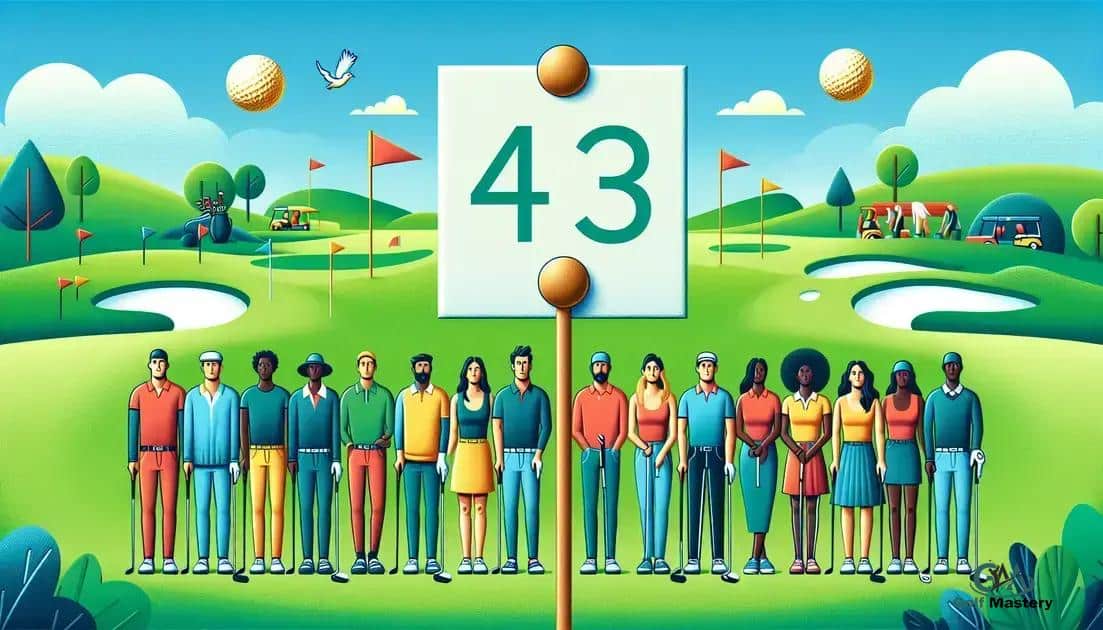Is a 43 good in golf? This guide reveals how this score impacts your game and overall performance in golf tournaments.
A score of 43 in golf is an impressive benchmark for beginners, reflecting strong skills and understanding of the game. It indicates a solid grasp of course management and can boost confidence, encouraging further improvement and enjoyment in the sport.
Is a 43 good in golf? This question often lingers in the minds of golfers seeking to improve their game. Whether you’re a beginner or a seasoned player, understanding golf scores is essential for tracking progress. In this article, we explore what a score of 43 signifies, how it compares to average scores, and practical tips for improving your game.
Understanding Golf Scoring
Understanding golf scoring is crucial for any golfer looking to improve their game. In golf, each hole has a specific par value, which represents the number of strokes an expert player is expected to take to complete it. The total par for an entire round, usually consisting of 18 holes, can significantly influence your overall score and evaluation.
What Does Each Score Mean?
When you complete a hole, your score is determined by how many strokes you took compared to the par. If you score below par, it’s excellent. For instance, if the hole is a par 4 and you complete it in 3 strokes, you made a birdie. Conversely, if you take 5 strokes, it’s a bogey.
The Importance of the Scorecard
Your scorecard is not just a record; it’s an essential tool for assessing your game. Each time you play, keeping track of your scores can help you identify patterns and areas for improvement. Comparing your scores over time shows your progress and helps you set realistic goals for better performance.
Average Scores in Golf
Most amateur golfers aim to score around 90-100 for a full round, with scores in the 70s considered exceptional. A score of 43 for 9 holes can be quite good, especially for a golfer just starting or playing in a more casual setting. It’s essential to recognize that everyone’s skill level differs, and scoring should be viewed in that context.
Other Factors Influencing Scores
Many conditions can affect golf scores, such as weather, course difficulty, and equipment. Understanding these variables can shape how you approach the game and help you make necessary adjustments to improve.
Practice Makes Perfect
Ultimately, grasping golf scoring is the first step to becoming a better player. The more you understand how scoring works, the more effectively you can practice and refine your skills. Always focus on enjoying the game and making progress on the course.
Comparing Golf Scores: The 43 Benchmark
When it comes to evaluating golf scores, comparing scores plays a vital role in gauging performance. A score of 43, depending on the context of the game, can indicate various levels of skill among golfers. Let’s break down what this benchmark score signifies.
Understanding the 43 Benchmark
A score of 43 typically applies to a 9-hole game. This means that the golfer has achieved an average of approximately 4.8 strokes per hole. For many beginners and intermediate players, scoring in this range can be a noticeable achievement.
How 43 Compares to Other Scores
In the broader context of golf:
- Score of below 40: This is generally excellent for 9 holes, indicating a skilled player.
- Score of 40-45: Represents a solid performance, especially for recreational golfers.
- Score above 45: This may signal that a player is still developing their technique and consistency.
Factors Influencing Your Score
Several elements can affect whether a 43 is considered good:
- Course difficulty: Different courses have varying levels of challenge.
- Player’s experience: A more experienced golfer may find 43 average, while a beginner may feel it is quite good.
- Weather conditions: Wind, rain, and temperature can impact performance.
Averaging Your Scores
To assess how well you are progressing, it’s important to average your scores over time. If you consistently score around 43, you might be on the verge of advancing your skills further, perhaps aiming to lower your score to the high 30s.
Getting Insights from Fellow Golfers
Engaging with other golfers can provide insights into how your score of 43 stacks up against theirs. Sharing experiences and tips can help you identify areas where you can improve your game. Overall, always remember that golf is about enjoying the game while pursuing your personal best.
Impact of a 43 on Your Game
A score of 43 can have a significant impact on your game. Whether you’re just starting out or you’ve been playing for a while, understanding what this score means can help you evaluate your performance.
Building Confidence
Scoring a 43 can boost your confidence, especially if it’s close to your personal best. This score can serve as motivation to keep playing and to work on mastering the skill of golf.
Setting Future Goals
Once you achieve a 43, you might set new goals to improve your score. Achieving lower scores, like aiming for the high 30s, becomes a realistic target. This progression can drive your practice sessions and make each game more exciting.
Identifying Areas for Improvement
When you analyze your score of 43, it’s important to break down your performance. Look at which holes caused you trouble. Identifying trends in your game can highlight specific areas that need improvement, whether it’s your short game, putting, or driving accuracy.
Understanding Course Management
Achieving a score of 43 often requires good course management. This means knowing when to play aggressively or conservatively. Understanding this balance improves decision-making and helps manage risks on the course.
Gaining Respect Among Peers
A score of 43 can earn you respect among fellow golfers, especially if you play with a diverse group. It’s a respectable score in many recreational circles, making you a competitive player in casual games or club tournaments.
Tips for Lowering Your Golf Score
Improving your golf score requires practice and the right strategies. Here are some tips for lowering your golf score that can help you see quick improvements on the course.
1. Focus on Your Short Game
Many strokes can be saved around the green. Prioritizing your short game, including chipping and putting, can lead to a lower score. Spend extra time practicing short shots to help reduce overall strokes.
2. Improve Your Course Management
Planning your shots wisely can greatly impact your score. Understand the layout of the course and make smart decisions. Avoid aiming for tight spots, and always consider playing more conservatively when needed.
3. Optimize Your Warm-up Routine
Before you play, a good warm-up can help. Spend 10-15 minutes stretching and hitting practice shots. Warming up prepares your body and mind, reducing stress, and improving your performance on the course.
4. Practice Your Putting
Pushing your putting skills can make a huge difference. Practice putting from various distances and angles to build confidence. Set up drills to improve your accuracy and speed on the greens.
5. Analyze Your Previous Rounds
Reviewing your past scores can provide insights. Look for patterns in your performance. Identify holes where you consistently score higher, and focus on improving those areas in your next game.
6. Stay Relaxed and Focused
Getting anxious about your score can hurt your game. Try to stay relaxed, take deep breaths, and focus on each shot. A positive mindset leads to better performance on the course.
7. Seek Professional Help
If you’re struggling, don’t hesitate to seek advice from a professional instructor. Lessons can provide personalized feedback and help you work on technique more effectively.
What Does a 43 Mean for Beginners?
For beginners, a score of 43 can be significant. It indicates where you stand in your journey to learn and enjoy the game of golf. Let’s look at what a score of 43 means for golfers who are just starting out.
Understanding the Score
A score of 43 in 9 holes translates to an average of about 4.8 strokes per hole. For beginners, this can be seen as a solid starting point. Many golfers aim to break 50 for 9 holes, making 43 quite impressive.
Building Confidence
Achieving a score of 43 can boost confidence for new players. This score can show that through practice, improvement is possible. Feeling good about your score encourages more play and practice, leading to further development.
Setting Realistic Goals
If you’ve just scored a 43, it’s a great time to set goals. You might aim to consistently break 45 or even work towards lower scores in future games. Setting goals helps track progress and keeps the game fun.
Learning from the Experience
Scoring 43 allows beginners to learn which aspects of their game need improvement. Whether it’s putting, driving, or approach shots, identifying strengths and weaknesses is essential for growth.
Comparing with Peers
Understanding how your score compares to other beginner golfers can help you gauge improvement. A score of 43 might place you among more skilled players, boosting motivation to keep practicing.
Encouragement to Keep Playing
Finally, a score of 43 can serve as a reminder to enjoy the game. It reflects that you can play competitively and have fun at the same time. Continuing to play will only enhance your skills while enjoying the process.
What You’ve Learned About a Score of 43 in Golf
In summary, understanding the significance of a score of 43 in golf can greatly benefit players, especially beginners. This score represents a solid achievement, providing a benchmark for improvement and encouraging personal growth. By focusing on the key areas such as the short game, course management, and mental strategies, golfers can enhance their performance and enjoy the game more.
As you practice and implement the tips provided, remember that consistent play and analysis will guide your journey. Celebrate your successes, set new goals, and most importantly, have fun on the course. A score of 43 is not just a number; it’s a stepping stone in your golfing adventure.
FAQ – Frequently Asked Questions About Scoring 43 in Golf
Is a score of 43 good for a beginner in golf?
Yes, a score of 43 is quite impressive for a beginner and indicates a solid understanding of the game.
What are some tips for breaking 43 in golf?
Focus on improving your short game, practice putting regularly, manage the course wisely, and analyze your previous rounds.
How can I improve my golf score?
You can lower your score by practicing consistently, focusing on specific areas of your game, and seeking advice from experienced players or golf instructors.
What does scoring a 43 indicate about my golfing skills?
Scoring a 43 indicates that you have a strong grasp of the game, and it reflects good decision-making and execution on the course.
How can I maintain my motivation after scoring 43?
Set new goals, track your progress, and remember to enjoy the game. Engaging with other golfers can also help maintain motivation.
Can I be competitive with a score of 43?
Yes, a score of 43 is competitive in most recreational settings, and it can earn you respect among your peers.






Leave a Reply